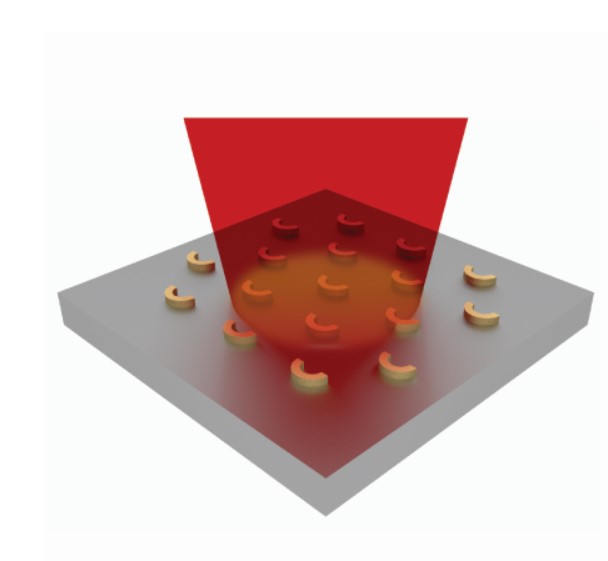Metallic Nanoarcs are Ready to Shine
The demand for plasmonic nanorods – teeny, tiny materials typically made of gold, silver or aluminum and boasting unique optical properties due to their size and shape – in biosensing and other technologies is increasing. Plasmonic nanoparticles act by absorbing and scattering light waves of specific frequencies, called resonances, similar to how hollow pipes enhance certain sound waves. By changing their shape, or tuning them, you can bolster their resonance and tailor their resonance frequency, thereby manipulating ‘color’ without change to the chemical composition of a material. Plasmonic nanoarcs – essentially, curved nanorods – are appealing building-blocks for chiro-optical materials, nonlinear optical media and directional waveguides. However, a big challenge in employing plasmonic nanoarcs in these applications is the lack of a universal method that can predictively tune their localized surface plasmon resonances (LSPRs) – waves of electrons, in a nutshell – to the desired optical wavelengths; thus, time-consuming numerical simulations are generally required. In a study recently published in the journal Optics Express, a University of Maryland (UMD) and Navy Research Laboratory (NRL) research team led by Oded Rabin, a Materials Science and Engineering (MSE) Professor, demonstrated a straightforward approach to predicting the resonance wavelengths of nanoarcs. Kunyi Zhang, a postdoctoral researcher at the Institute for Research in Electronics and Applied Physics (IREAP), served as first author on the paper. The study details a new understanding of the role of geometric variables in determining the resonance wavelengths, and oscillator strengths, of LSPRs in plasmonic nanoarcs. "Using transformation optics analysis, FTIR [fourier-transform infrared spectroscopy], and computational modeling, we were able to determine the impact of the arc length, arc width and central angle on the resonance wavelength, and tune the interval between the fundamental and 2nd-order resonances, making the nanoarcs more efficient in their applications," said Zhang. "These fundamental resonances are tunable across the near- and mid- infrared spectrum." The group focused exclusively on gold and aluminum nanoarcs situated on dielectric substrates. According to the study, the optical properties of nanorods and nanoarcs are related to each other through a mathematical method, namely, a conformal transformation. This means that the vast experimental data available on nanorod resonances can be used to predict the resonances of nanoarcs. These predictions were verified by measuring the far-field scattering spectra of plasmonic nanoarcs with infrared and visible spectroscopy. Some of the measurements carried out by Zhang were performed at the Advanced Light Source facility in Berkeley, Ca., which allows for the investigation of just a few nanoarcs at a time. Possible applications of these plasmonic structures include photovoltaics/solar cells, spectroscopy, imagery enhancement and radiation treatment for cancer patients. Financial support for the project was provided by the NSF’s DMR and UMD’s New Directions. For additional information: Kunyi Zhang, Andrew P. Lawson, Chase T. Ellis, Matthew S. Davis, Thomas E. Murphy, Hans A. Bechtel, Joseph G. Tischler, and Oded Rabin. "Plasmonic nanoarcs: a versatile platform with tunable localized surface plasmon resonances in octave intervals," Opt. Express 28, 30889-30907 (2020). https://doi.org/10.1364/OE.403728
November 20, 2020 Prev Next |


